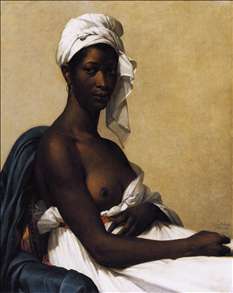French woman painter, ne Marie-Guillemine Leroulx-Delaville. She first studied with Elisabeth
Vige-Lebrun in 1781 and in 1786 worked in the studio of Jacques-Louis
David. In 1784 she met the poet Charles-Albert Demoustier (1760-1801), and the figure of Emilie in his Lettres de la mythologie represents Benoist. She exhibited at the Salon in 1791 (Psyche Taking Leave of her Family) and obtained a gold medal there in 1804. Her reputation as a portrait painter brought her commissions from Napoleon and his family: in 1803 the portrait of the emperor Napoleon (1804; Ghent, Law Courts) for the town of Ghent; in 1805 that of Marshal Brune (destroyed; copy Versailles, Chteau) for the Tuileries; in 1807 that of Pauline Bonaparte (Versailles, Chteau). She also executed the portraits of Marie-Elise, Grand Duchess of Tuscany (Lucca, Pinacoteca Nazionale) and the empress Marie-Louise (Fontainebleau, Chteau).
She made her name with the semi-nude
Portrait of a Negress (exhibited on the Salon 1800; Paris, Louvre), in which she broke with the graceful style of her early works. Benoist also attempted genre scenes, for example The Fortune-teller (1812; Saintes, Muse des Beaux-Arts) and the Bible Reading (exhibited on the Salon 1810; Louviers, Muse Municipal), an intimate scene close to those of Martin Drolling, although with less emphasis on detail and anecdote than on sentiment. On the restoration of the Monarchy in 1815, her husband, the advocate Pierre-Vincent Benoist, whom she had married in 1793, was made a member of the Council of State and, although at the summit of her career, she was obliged to abandon painting.
If you want write a review , you have to be registered.
